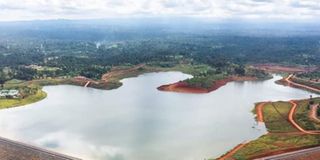Why Thiba dam is a blessing to Mwea rice growers

The Sh20 billion Mwea Thiba dam which is meant to boost rice production in this photo taken in July 2022.
Thousands of rice farmers are basking in joy following the completion of the much-awaited Sh20 billion mega Thiba dam meant to boost production in the expansive Mwea Irrigation Scheme in Kirinyaga County.
The dam that was finished last month is currently being filled with water before it is distributed for irrigation.
The 11,000 farmers who grow rice in the 22,000-acre scheme are to reap big as the project will open up 10,000 extra acres of rice.
This dam will also enable farmers to grow rice twice a year to increase production and generate more income to improve their living standards.
The dam will allow farmers to double production from the current 140,000 tonnes to 280,000 annually.
Rice farmers now earn Sh9 billion per year but with the new dam, the amount could rise to Sh18 billion.

National Irrigation Authority Chief Executive Officer Mr Gitonga Mugambi unveils the impounding of water into the Thiba dam which has been completed.
Mauricious Mutugi, the chairman of the scheme's Water Users Association, described farmers as hardworking people who will use the dam to create greater wealth.
"Farmers will make a killing following the building of this dam by the Jubilee government," said Mr Mutugi.
The dam is being filled with water in readiness for the expansion of rice farming. It is equipped with a spillway that will prevent flooding during rainy seasons, and has a capacity for 15 million cubic metres of water.
Built on River Thiba, 130km from Nairobi, the dam is 40 metres high and one kilometre wide.
The dam is expected to be key in fighting the effects of climate change as its water will be used during dry seasons and that is why the National Irrigation Authority (NIA) is collaborating with the Ministry of Environment to preserve water towers.
The Thiba dam project is seen as one of the pillars of the government to fight hunger and improve manufacturing.
"Through irrigated agriculture, we will be able to have more products for the manufacturing sector through value addition," said NIA Chief Executive Officer Gitonga Mugambi as he announced the completion of the project.
Double cropping
Mr Mugambi explained that double cropping, which will be brought about by the dam, means more income in the local economy.
He noted that the project will help in improving water storage during dry periods.
Farmers said the problem of water scarcity is now history.
"We shall have enough water to grow rice for two seasons per year. In the past we used to experience acute water shortages and it was hard to carry out extensive farming,” said farmer John Kinyua.
“Sometimes our Water Users Association leaders used to ration water, especially during hot weather because the commodity was not adequate for everyone."
Mr Kinyua observed that there was little water during dry seasons, forcing farmers to plant rice only once a year.
Started in 2018, the dam was expected to be completed in four years. However, it took almost five years to complete after Strabag, a Germany firm, halted works temporarily in 2020 after the government delayed releasing funds to pay workers and build the dam.
The dam, funded by the government with support from Japan International Cooperation Agency (JICA), is a major project that is expected to enhance food security.
The Mwea scheme, believed to be the largest in East and Central Africa, is the country's rice granary, producing 80 per cent of rice consumed in Kenya.
But the produce is below local consumption and Kenya relies on imports to cover the deficit. But with completion of the Thiba dam, the government is determined to ensure more rice is grown to meet demand.
"This is historic. As farmers, we thank the government for providing such an important dam to us. Our economy will grow tremendously," said Mr Mutugi.
For decades, farmers have been suffering due to lack of sufficient water to irrigate their crop and to expand rice farming in the scheme and the building of the dam was thus important to farmers who depend on the crop for their livelihood.
"The completion of the dam marks an important day for Mwea farmers and the country at large. Farmers will see a new beginning in the sense that the dam will enable them to double production and increase their income," said Mr Mugambi.
The NIA, he said, was proud to be associated with the project.
He attributed the success to concerted efforts by the NIA, farmers, local national government administrators and the Japanese government, one of major financiers.
Now that the dam has been completed, the NIA will focus on managing water to ensure maximum rice production.
Mr Mugambi said the water will flow to the dam for 20 days before farmers are allowed to use it.
He added that the government is determined to produce enough rice to feed Kenya’s rising population and have a surplus for export.
Besides irrigation, farmers will benefit from more health facilities as the government will set up a hospital near the dam.
When President Uhuru Kenyatta visited the site recently, he announced that a modern hospital would be built to serve the farmers.
Greater productivity will also create more employment opportunities and reduce poverty.
More water will also be available for domestic and livestock use.
Kirinyaga East Deputy County Commissioner James Wanyoike said farmers would benefit greatly and asked them to use the dam well.
But he warned residents to be careful to avoid drowning in the dam.
"We want residents to be safe and therefore they should keep away from the dam," he said.





